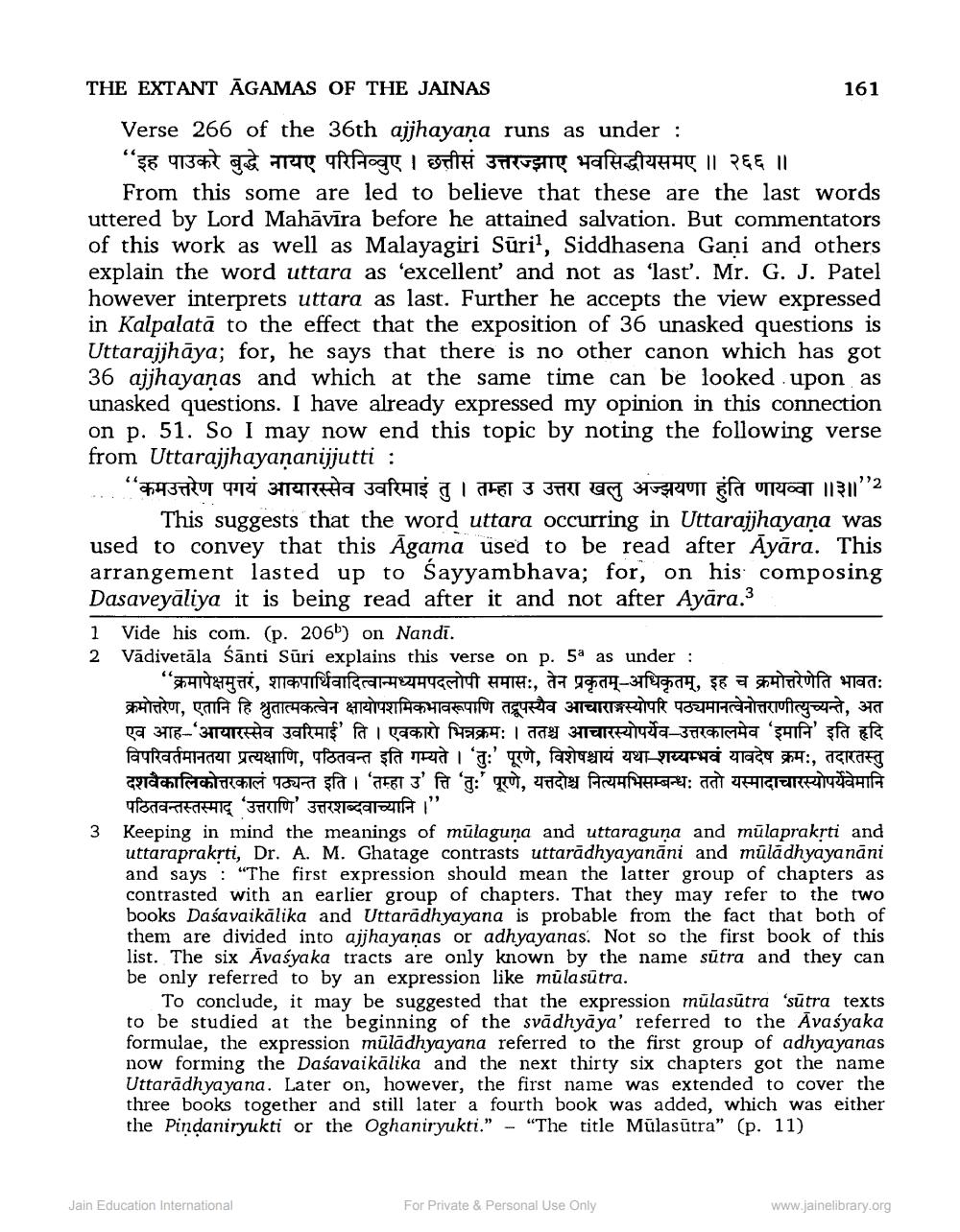________________
THE EXTANT ĀGAMAS OF THE JAINAS
161
Verse 266 of the 36th ajjhayaņa runs as under: “इह पाउकरे बुद्धे नायए परिनिव्वुए । छत्तीसं उत्तरज्झाए भवसिद्धीयसमए ॥ २६६ ॥
From this some are led to believe that these are the last words uttered by Lord Mahāvīra before he attained salvation. But commentators of this work as well as Malayagiri Sūril, Siddhasena Gani and others explain the word uttara as 'excellent and not as 'last'. Mr. G. J. Patel however interprets uttara as last. Further he accepts the view expressed in Kalpalatā to the effect that the exposition of 36 unasked questions is Uttarajjhāya; for, he says that there is no other canon which has got 36 ajjhayanas and which at the same time can be looked upon as unasked questions. I have already expressed my opinion in this connection on p. 51. So I may now end this topic by noting the following verse from Uttarajjhayananijjutti : ..."#4372Ut quri Pria Jaf415 I I JEET 3 JAKT CA 3455euzfa upproat 11301'2
This suggests that the word uttara occurring in Uttarajjhayana was used to convey that this Agama used to be read after Ayāra. This arrangement lasted up to Sayyambhava; for, on his composing Dasaveyāliya it is being read after it and not after Ayāra.3 1 Vide his com. (p. 206b) on Nandi. 2 Vādivetāla śānti Sūri explains this verse on p. 5a as under:
"क्रमापेक्षमुत्तरं, शाकपार्थिवादित्वान्मध्यमपदलोपी समासः, तेन प्रकृतम्-अधिकृतम्, इह च क्रमोत्तरेणेति भावत: क्रमोत्तरेण, एतानि हि श्रुतात्मकत्वेन क्षायोपशमिकभावरूपाणि तद्रूपस्यैव आचाराङ्गस्योपरि पठ्यमानत्वेनोत्तराणीत्युच्यन्ते, अत एव आह-'आयारस्सेव उवरिमाई' ति । एवकारो भिन्नक्रमः । ततश्च आचारस्योपर्येव-उत्तरकालमेव 'इमानि' इति हृदि विपरिवर्तमानतया प्रत्यक्षाणि, पठितवन्त इति गम्यते । 'तुः' पूरणे, विशेषश्चायं यथा शय्यम्भवं यावदेष क्रमः, तदारतस्तु दशवैकालिकोत्तरकालं पठ्यन्त इति । 'तम्हा उ' त्ति 'तुः पूरणे, यत्तदोश्च नित्यमभिसम्बन्धः ततो यस्मादाचारस्योपर्येवेमानि पठितवन्तस्तस्माद् 'उत्तराणि' उत्तरशब्दवाच्यानि ।" Keeping in mind the meanings of mūlaguna and uttaraguna and mūlapraksti and uttaraprakrti, Dr. A. M. Ghatage contrasts uttarādhyayanāni and mūladhyayanāni and says: "The first expression should mean the latter group of chapters as contrasted with an earlier group of chapters. That they may refer to the two books Daśavaikālika and Uttaradhyayana is probable from the fact that both of them are divided into ajjhayanas or adhyayanas. Not so the first book of this list. The six Avasyaka tracts are only known by the name sūtra and they can be only referred to by an expression like mula sūtra.
To conclude, it may be suggested that the expression mūlasūtra 'sūtra texts to be studied at the beginning of the svādhyāya' referred to the Avasyaka formulae, the expression mulādhyayana referred to the first group of adhyayanas now forming the Daśavai kālika and the next thirty six chapters got the name Uttarādhyayana. Later on, however, the first name was extended to cover the three books together and still later a fourth book was added, which was either the Pindaniryukti or the Oghaniryukti." - "The title Mülasūtra" (p. 11)
3
Keeping in mind, the M. Ghatage Should mean the li
Jain Education International
For Private & Personal Use Only
www.jainelibrary.org




